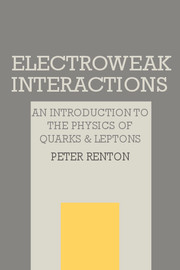Book contents
- Frontmatter
- Contents
- Preface
- 1 Introduction
- 2 Towards a quantum field theory
- 3 Wave equations, propagators and fields
- 4 Quantum electrodynamics
- 5 From Fermi theory to the standard model
- 6 Purely leptonic interactions
- 7 Deep inelastic scattering and quantum chromodynamics
- 8 Weak hadronic currents, electroweak interference effects
- 9 Quark and lepton oscillations
- 10 The standard model and beyond
- Appendix A Units
- Appendix B Properties of γ-matrices
- Appendix C Cross-sections, decay rates and Feynman rules
- Appendix D Dirac δ-function
- Appendix E Fierz transformation
- Appendix F Creation and annihilation operators for a Dirac field
- References
- Index
5 - From Fermi theory to the standard model
Published online by Cambridge University Press: 05 August 2012
- Frontmatter
- Contents
- Preface
- 1 Introduction
- 2 Towards a quantum field theory
- 3 Wave equations, propagators and fields
- 4 Quantum electrodynamics
- 5 From Fermi theory to the standard model
- 6 Purely leptonic interactions
- 7 Deep inelastic scattering and quantum chromodynamics
- 8 Weak hadronic currents, electroweak interference effects
- 9 Quark and lepton oscillations
- 10 The standard model and beyond
- Appendix A Units
- Appendix B Properties of γ-matrices
- Appendix C Cross-sections, decay rates and Feynman rules
- Appendix D Dirac δ-function
- Appendix E Fierz transformation
- Appendix F Creation and annihilation operators for a Dirac field
- References
- Index
Summary
Nuclear beta decay has played a very important historical role in the development of our present understanding of weak interactions. For more than 20 years these reactions were the primary source of information on the weak force. In the first part of this chapter, the theoretical ideas developed to account for the experimental measurements on beta decays (and later on the weak decays of hadrons) are reviewed, leading to the V – A theory of weak interactions. This theory, however, gives badly divergent cross-sections at high energy and, moreover, does not account for the weak neutral current interactions which are observed in nature. The standard model of Glashow, Salam and Weinberg, which is based on the principle of local gauge symmetry, predicted such currents and, indeed, successfully explains the bulk of all experimental measurements on weak and electromagnetic phenomena. After discussion on the basic framework of this model, the problem of the introduction of particle masses is reviewed. Non-zero masses would appear to violate the required gauge invariance of the theory. However, if the underlying group symmetry is spontaneously broken, then the particle masses can be generated at the price of introducing one or more fundamental scalars (Higgs particles) into the theory. The predictions of the standard model, for a wide class of reactions, together with a comparison of the experimental results, are discussed in subsequent chapters.
- Type
- Chapter
- Information
- Electroweak InteractionsAn Introduction to the Physics of Quarks and Leptons, pp. 202 - 258Publisher: Cambridge University PressPrint publication year: 1990



